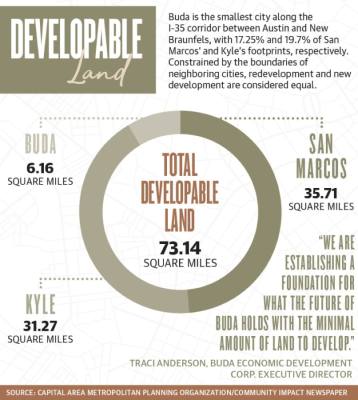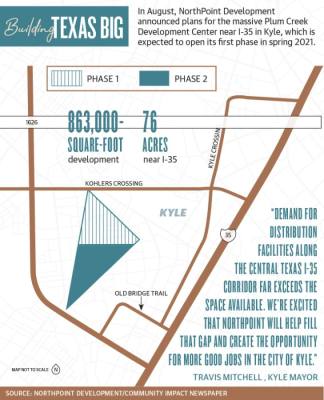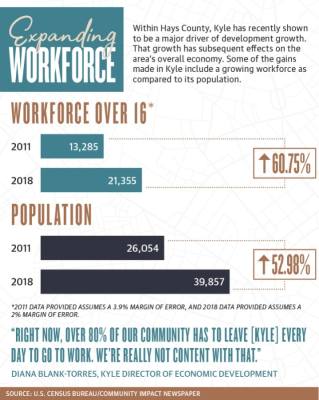On Sept. 30, the Greater San Marcos Partnership put a bow on its strongest fiscal year since its creation a decade ago, beating previous years by a rough factor of three to one, according to GSMP President Jason Giulietti.
“We had more than six and a half-billion dollars of capital expenditure projects considering our region as a location for their company. That translates into more than 25,000 jobs if everything closes,” Giulietti said. “For perspective, we haven’t seen numbers like that ever. We're typically seeing around 2 billion a year, so for us to see more than six is very, very significant.”
While GSMP covers both Hays County and Caldwell County, and those projects are not locked in yet, a significant portion of that investment would land along I-35 between San Marcos and Buda in what has been referred to as the innovation corridor.
Kyle emerges as growth leader
Long known as a bedroom community, the city of Kyle aims to reshape itself into a more well-rounded and self-sufficient community, according to Diana Blank-Torres, Kyle’s director of economic development.
“Right now, over 80% of our community has to leave [Kyle] every day to go to work,” Blank-Torres said. “We’re really not content with that.”
The city and her department have spent the last 15 years convincing developers that Kyle was the right location for commercial projects, with the hope of attracting skilled and high-paying positions for the city’s residents.
“We went after everything,” Blank-Torres said. “Now we are going after the suppliers, the medical manufacturers, biotech—that kind of thing.”
Progress was difficult until the 2008 recession forced many companies to examine more affordable development sites around the Austin area—places like Kyle. Over the last few years, Blank-Torres said, efforts have begun to pay off in a big way.
In December 2018, Majestic Realty broke ground on the 535,113-square-foot Kyle Crossing Business Park a block west of I-35 in the 2,200-acre Plum Creek development. Within two years, just shy of 80% of the facility’s two buildings have been leased.
“Before we even had a [certificate of occupancy], they announced Amazon,” Blank-Torres said. “Then they announced Lowes in the second building.”
Brian Masterman, a senior vice president with Majestic Realty, said that speed of execution is a large factor for large companies looking at spaces like Kyle Crossing, and the city’s efforts went a long way toward cinching these deals.
“Being able to perform for these larger companies and do it in a way that meets their timelines, it can be a lot of work,” Masterman said. “The city really pulled out the stops and helped us deliver.”
Amazon will use its Kyle Crossing facility for a sortation center that will employ upward of 200 people. Lowes has not announced the number of jobs its facility will create, but it is not the only large facility in the city’s pipeline.
Northpoint Development announced plans in August to build called the Plum Creek Development Center, an 863,000-square-foot facility. The first two buildings have a combined 444,058-square-feet of space and were expected to come online in the second quarter of 2021.
ENF Technology broke ground on a $45 million, 75,000-square-foot headquarters and manufacturing facility on Koehlers Crossing in January that could employ up to 80 people.
Masterman noted that there is a ripple effect when high-skill manufacturing facilities such as ENF plant roots. Larger facilities for distribution and supply chain management set up shop around them and create additional jobs.
While these projects were marked as big wins for Kyle’s economic development team, it hasn’t all been smooth sailing.
Smile Direct Club canceled plans to build a $37 million manufacturing facility in Kyle’s Hays Logistic Center due to the coronavirus pandemic. It would have employed 850 people and been the city’s largest employer.
However, economic development is often about the long game and Blank-Torres said that the local economy has benefited in some ways from the pandemic.
“It has kind of been a proving ground for us that you don't have to be smack in the middle of downtown Austin in order to be successful,” Blank-Torres said. “I think a lot of people are going to be shocked about what our local economy actually is for the past year, because it's not gloom and doom.”
Masterman predicted that the demand for the type of large facilities springing up in Kyle will continue to grow as businesses transition away from retail outlets over the next several years.
“In order to do that, the big change in Austin is moving away from say, the 100,000- to 150,000-square-foot buildings being the expected template type,” Masterman said. “Now it’s going to be a 150,000- to 350,000-square-foot building.”
One of the factors benefiting Kyle’s growth in these project types is the amount of available land. Unlike cities such as Buda, Austin or Round Rock, land for large-footprint developments is bountiful.
“Kyle is only 30% [built out] right now,” Blank-Torres said. “That’s kind of mind-boggling to think about with what we’ve got coming still.”
San Marcos faces growing pains
San Marcos is planning for substantial growth in population and commercial development for the next few decades, which is largely being driven by workforce development at Texas State University and future infrastructure projects, according to Jason Giulietti, president of the Greater San Marcos Partnership.
“Having Texas State; having such a large growing population center; Hays County being the fastest growing county in the country, I think helps really validate for companies that their workforce is here,” Giulietti said.
He also said that investments from large businesses— such as California-based Katerra, which has put on hold an agreement with the city to create at least 542-full-time jobs paying a minimum of $15 per hour—spurs growth in ancillary sectors of the economy, providing a boost to small businesses.
This comes by way of increased shopping and dining by residents or people working in the area with more disposable income, according to Giulietti. It also comes through the formation of new businesses by the talent imported to San Marcos.
“The type of companies we're attracting are really innovators in their industry,” Giulietti said. “Over time as they continue to innovate and develop products, individuals will spin out or take new ideas and collaborate with the university or... start their own business, and create another opportunity. And we're seeing that that's happening as well.”
However, the challenge for San Marcos city planners isn’t just today’s growth, but also the 267% increase to the population projected over the next 25 years.
The Capital Area Metropolitan Planning Organization and the city partnered this year on the San Marcos Platinum Planning Study to develop ideas on how to direct growth strategically into hubs in downtown, midtown and the medical district.
A spokesperson for CAMPO said in an email that among the themes in public comments for the study was the belief that developments that encourage small local business growth should be supported.
“We're trying to make sure that we're bringing the right employers to the community that complement the assets and the great things that are here, or not [here],” Giulietti said.
One of the infrastructure challenges already apparent is low wages and a lack of affordable housing.
According to a 2019 study commissioned by the city, the median rent for a one-bedroom apartment is $898, and 5,953 households spend at least half of their income on housing. An estimated 2,760 of these households are students with parental support.
“We need to ensure that we have an ability to have good quality of life, and that can mean anything from a multifamily housing unit because we still don't have wages where we need them to be,” Giulietti said. “Folks at all income levels need to be able to reside here, and that's a big piece of what we're trying to do. A lot of that is keeping affordable housing as part of the conversation.”
Buda development constrained
Commercial development in Buda is faced with the challenge of how to maximize the potential of a limited footprint of 6.16 square miles—17.25% and 19.7% of San Marcos’ and Kyle’s footprints, respectively—not all of which is developable.
According to Traci Anderson, executive director of the Buda Economic Development Corporation, that means planning as much for redevelopment as new development, which involves studies, analyses and updates to the city’s comprehensive plan.
“You see, we are establishing a foundation for what the future of Buda holds with the minimal amount of land to develop,” Anderson said in an email. “We want to be strategic and receive the highest and best use for our remaining properties to really make Buda a destination.”
The challenge is large enough that she said old quarry sites were being developed upon and old dumpsites were under consideration for remediation and revitalization—all to squeeze the most potential from the developable land. Other upcoming projects would provide infill to downtown Buda.
One priority for the BDEC was business retention and expansion, and reducing the 36-minute one-way commute time the average Buda resident deals with, as found in a recent study by Retail Coach.
“Buda is working diligently to discover what it wants to be when it grows up,” Anderson said. “The recent years have shown significant growth and [Buda] has just been trying to keep up with what has been coming in. We are starting the groundwork to truly see where Buda wants to be and what they want to actively pursue.”









